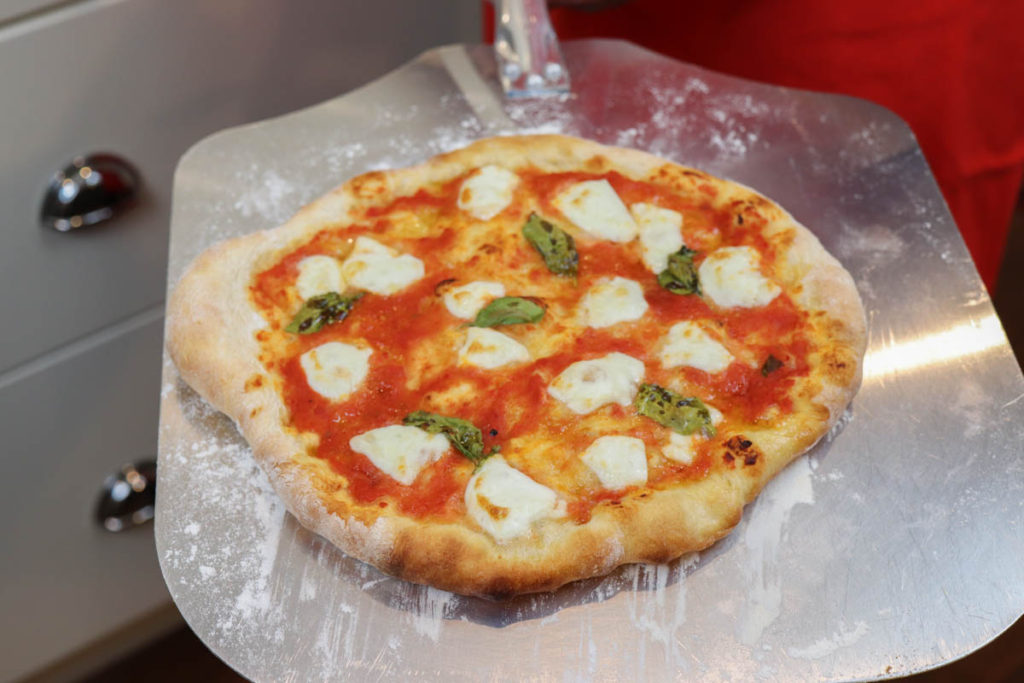Yes, Pizza with capital P and exclamation marks because it is my absolutely favorite food.
This amazing savory pie is very simple in its ingredients and yet so hard to replicate in the traditional way. Hard because you need the right ingredients – amazingly, just a handful – but they must be the right ones: Water, salt yeast and flour for the dough, fresh mozzarella, tomatoes, basil or oregano for the topping.
Sounds pretty simple, doesn’t it? But what is the key component to obtain a real great pizza is the oven: according to the AVPN (the True Neapolitan Pizza Association) “The cooking must be done exclusively in a wood-fired oven, which has reached a temperature between 430-480C°. With these temperatures, just insert the pizza for 60-90 seconds. The pizza will cook evenly across the entire circumference.”
Of course – or unfortunately – there are hundreds of variations of the original recipe – deep dish, thin crust, endless choice of toppings, cheesy crust, even baked in the barbecue – but for me the one and only pizza remains the Pizza Napoletana Verace, the True Neapolitan Pizza.
The AVPN is a non-profit organization founded in 1984 in Naples and its mission is to promote and protect in Italy and worldwide the true Neapolitan pizza, made in accordance with the characteristics described in the AVPN International Regulations
Just a brief look at the Association’s method of production – a 14-page document called Disciplinare – will give you an idea of how important it has become to preserve the authenticity of pizza, not only in Naples but all over the world.
The Disciplinare regulates everything: from the type of flour to be used to the pH of water, from the duration of the dough rising (called fermentation) to the weight of the dough balls (panetti), the diameter of the pizza, the three variations of tomatoes and two certified kinds of mozzarella.
Most importantly, the AVPN recognizes only two types of Pizza: ‘Marinara’ (tomato, oil, oregano, and garlic) and ‘Margherita’ (tomato, oil, mozzarella or fior di latte, grated pecorino cheese and basil).
And if you have heard that Pizza Margherita was named after a queen, I believe that the story is true because Margherita of Savoy wasn’t the typical queen of her time. She traveled all over Italy on her husband’s behalf with the scope of making popular the royal house of the recently united country, which she achieved thanks to her ability to show her genuine enthusiasm for local customs, traditions and culture. She was particularly fond of Naples, her first residence and the town where her only child was born. I can easily picture her going to eat the local food and also why a very honored pizzaiolo decided to name a pizza after his queen. Hosting royalty was a rare event to pass on to posterity and it’s easy to make the connection between the colors of the popular food and those of the Italian flag: red tomatoes, green basil, and white cheese.
A wood-fired oven still remains one of my dreams, but over the years I have learned a few tricks to make a good pizza at home.
I have bought a high-quality pizza stone that mimics the base of a wood-fired oven and gives my pizza a nice crust; I make my own very simple tomato sauce; I use only fresh buffalo mozzarella, fresh basil, and cold-pressed organic extra-virgin Italian olive oil.
In spite of all my efforts, I must admit that no pizza I’ve ever made compares to a True Neapolitan Pizza eaten in Naples: some people say it’s the flour, others swear it’s the local water, others maintain it’s the sea air that makes it unique. I believe it’s a combination of all these factors plus the tomatoes grown in volcanic soil, the freshness of local mozzarella, the wood they use in the oven, but mainly the skills of the pizzaioli, refined and perfected over centuries of baking their acclaimed and unique pizza.

